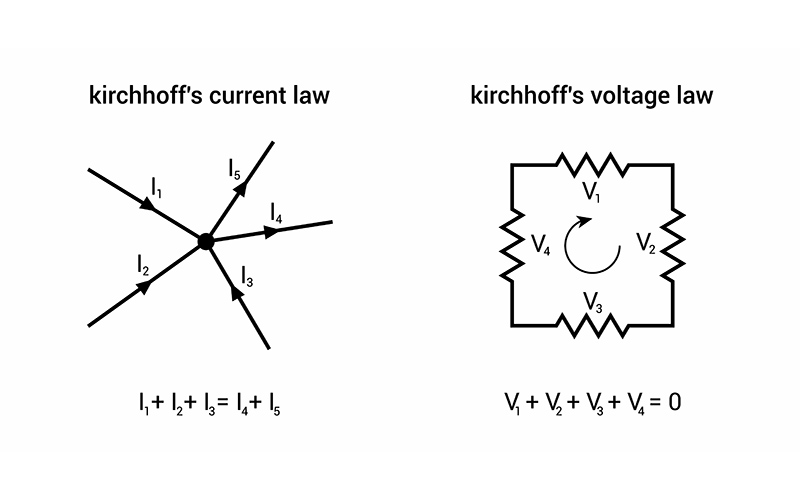Within electrical engineering, Kirchhoff’s laws are pivotal for analysing complex circuits. Developed by Gustav Kirchhoff in the 19th century, these laws provide the tools necessary to determine currents and voltages across networks. Kirchhoff’s Current Law (KCL) and Kirchhoff’s Voltage Law (KVL) are especially crucial for students and professionals looking to enhance their circuit analysis skills.
Kirchhoff’s Current Law (KCL)
KCL states that the total current entering a junction must equal the total current leaving the junction. This law is based on the principle of charge conservation, where the algebraic sum of currents in a network of conductors meeting at a point is zero.
Example application:
Consider a simple junction where three currents converge. If two of the currents entering the junction are 5A and 3A, and one current leaving the junction is 7A, KCL can determine the second outgoing current:
5𝐴 + 3𝐴 = 7𝐴 + 𝐼
𝐼 = 1𝐴
This tells us that an additional 1A must be leaving the junction to balance the incoming and outgoing currents.
Kirchhoff’s Voltage Law (KVL)
KVL deals with the energy conservation around a closed loop. It posits that the total sum of the electrical potential differences around any closed network is zero. Essentially, the sum of the electromotive forces and voltage drops in a closed loop must balance out to zero.
Example application:
In a closed circuit containing a battery with an electromotive force of 12V and two resistors with voltage drops of 7V and 4V, KVL helps ensure that the voltages around the circuit comply with the law:
12𝑉 – 7𝑉 – 4𝑉 = 0𝑉
This equation confirms the circuit is balanced, showing that the voltage provided by the battery is equal to the voltage drops across the resistors.
Practical importance of Kirchhoff’s Laws
- Circuit analysis and troubleshooting: Kirchhoff’s laws are essential for identifying errors in complex circuits, allowing engineers to effectively troubleshoot issues by analysing current paths and voltage drops.
- Design and simulation: Engineers use these laws to design more efficient circuits and to simulate their behaviour under different conditions, ensuring functionality and safety.
- Educational value: These laws are fundamental in electrical engineering education, helping students understand the flow of electricity and the principles of circuit design.
Kirchhoff’s laws are indispensable tools in the field of electrical engineering, providing a foundation for analysing, designing, and troubleshooting electrical circuits. By mastering these laws, professionals and students alike can enhance their understanding of circuit behaviour and improve their ability to develop innovative solutions in technology.
Understanding and applying Kirchhoff’s Current Law (KCL) and Kirchhoff’s Voltage Law (KVL) can lead to profound insights into the functionality of complex electrical systems, affirming their critical role in the advancement of electrical engineering and technology.




